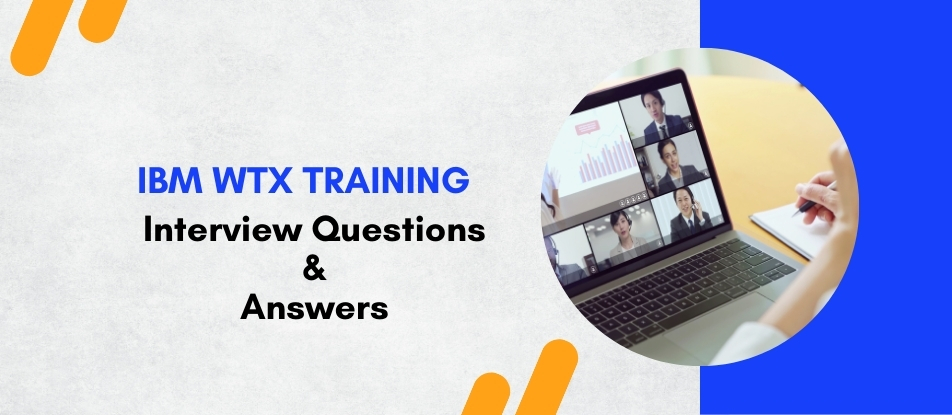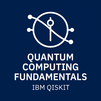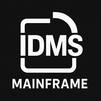
Dive deep into the capabilities of IBM WTX with our training course. This program is designed for experienced users looking to master data integration and transformation techniques. Learn to create complex type trees, optimize map performance, and integrate with external systems like IBM Integration Bus. The course also covers error handling, security implementations, and deployment strategies, ensuring you can manage sophisticated data transformation scenarios efficiently.
IBM WTX Interview Questions Answers - For Intermediate
1. What is a functional map and how is it used in WTX?
A functional map in WTX is a reusable component that defines a specific transformation logic. It can be invoked from other maps to perform common transformation tasks, promoting modularity and reuse in project development.
2. How does WTX handle large data volumes?
WTX is capable of handling large data volumes through streaming and partitioning techniques. It processes data in chunks, reducing memory overhead and improving performance in large-scale transformation scenarios.
3. Can WTX be used for real-time data processing?
Yes, WTX can be configured for real-time data processing by deploying it in environments that support real-time data capture and transformation, such as message-oriented middleware. This enables WTX to process data as it flows between systems without significant delay.
4. What debugging tools are available in WTX?
WTX offers several debugging tools, including the ability to step through maps in the Design Studio, watch variable values, and log execution details. These tools help developers identify and fix issues within the transformation logic.
5. How does WTX handle complex data transformations?
WTX handles complex data transformations using a combination of functional maps, custom functions, and external calls to databases or APIs. It supports complex conditional logic, looping, and data aggregation to meet diverse transformation requirements.
6. What are lookup tables and how are they used in WTX?
Lookup tables in WTX are used to store key-value pairs that can be accessed during transformations to enrich or validate data. They are particularly useful for replacing codes with meaningful descriptions or for validation against predefined lists.
7. Explain the role of the Command Server in WTX.
The Command Server in WTX manages the execution of maps from remote locations. It allows users to run maps via command-line instructions, making it easier to integrate WTX transformations into automated workflows and batch processes.
8. How is data validation performed in WTX?
Data validation in WTX is performed using type trees that define data formats and constraints. Maps can include validation logic to check data accuracy and completeness before proceeding with transformations.
9. What is the Integration Flow Designer and how is it used?
The Integration Flow Designer in WTX is a graphical tool used to design and deploy integration solutions that involve complex data transformations. It helps in visually orchestrating how data moves and transforms across different systems and applications.
10.. How can external applications trigger transformations in WTX?
External applications can trigger transformations in WTX through APIs, message queues, or direct database operations. WTX provides adapters and connectors that facilitate these interactions, allowing seamless integration with a variety of external systems.
11. Discuss the scalability options for WTX.
WTX scales by deploying on multiple servers or in clustered environments. It can handle increased loads by distributing transformations across multiple instances, which can be dynamically adjusted based on the workload.
12. What are the best practices for maintaining WTX maps?
Best practices for maintaining WTX maps include regular updates to type trees and maps, thorough testing, consistent documentation, and adherence to coding standards. Regular reviews and optimizations of maps ensure that transformations remain efficient and error-free.
13. Can WTX be used in cloud environments?
Yes, WTX can be deployed in cloud environments, taking advantage of cloud infrastructure for flexibility, scalability, and cost-efficiency. Cloud deployments can enhance the accessibility and reliability of WTX transformations.
14. What support is available for WTX users?
Support for WTX users includes documentation, community forums, and direct support from IBM through technical support contracts. IBM also offers training and certification programs to help users maximize their use of WTX.
15. How does WTX handle internationalization and localization?
WTX supports internationalization and localization by handling multiple character sets and time zone conversions. It ensures that data is appropriately formatted and transformed according to local standards and practices, which is crucial for global applications.
IBM WTX Interview Questions Answers - For Advanced
1. Describe the audit and logging capabilities in WTX and how they can be leveraged for compliance and monitoring.
WTX provides extensive audit and logging capabilities that record detailed information about data transformations, including execution times, outcomes, and error details. These logs can be used for troubleshooting, performance monitoring, and compliance auditing. WTX logs can be integrated with enterprise monitoring tools to provide real-time insights into the health and performance of the data transformation processes.
2. What are the implications of integrating WTX with big data platforms, and how can it be achieved?
Integrating WTX with big data platforms involves using WTX’s ability to handle large volumes of diverse data formats to preprocess or transform data before it is loaded into big data systems. This can be achieved through direct connections to big data platforms or through batch processes that prepare data for analytics. The implications include enhanced data quality and accessibility for big data analytics applications, enabling more accurate and comprehensive analyses.
3. How can WTX contribute to IoT (Internet of Things) data management strategies?
WTX can play a significant role in IoT data management by transforming data generated from IoT devices into formats suitable for analysis and storage. WTX can process this data in real-time or batch modes, apply necessary transformations for standardization and aggregation, and integrate it with enterprise systems or analytics platforms. This capability is crucial for leveraging IoT data in operational processes and decision-making.
4. Discuss the role of WTX in a multi-cloud environment and its benefits and challenges.
In a multi-cloud environment, WTX can facilitate data integration and transformation across different cloud platforms. This flexibility helps organizations avoid vendor lock-in and optimize costs by using the best-suited cloud services. However, the challenges include managing the complexity of multiple cloud APIs, ensuring consistent data security across clouds, and handling potential data transfer delays or costs.
5. Explain how advanced data mapping techniques can be applied in WTX to solve complex integration scenarios.
Advanced data mapping techniques in WTX, such as using recursive maps, dynamic mapping, and external function calls, enable developers to address complex integration scenarios. These techniques allow for the transformation of highly complex or variable data structures and the integration of logic that adapts to data context. Solving these scenarios often involves a deep understanding of both the source and target systems and the ability to implement efficient and maintainable transformation logic.
6. What are the considerations for WTX deployment in hybrid IT environments?
In hybrid IT environments, where resources are distributed across on-premises and cloud platforms, WTX deployment must consider network connectivity, data security, and consistent configuration management. Ensuring seamless data flow between on-premises and cloud components requires robust networking solutions, often involving VPNs or dedicated links. Security measures must be uniform across all environments, including consistent encryption practices and unified access controls. Additionally, configuration management tools should be used to maintain consistent deployments and updates across different platforms.
7. How can WTX be utilized for data governance and compliance initiatives?
WTX plays a crucial role in data governance and compliance by ensuring that data transformations adhere to relevant standards and regulations. It can enforce data integrity, accuracy, and consistency through validation rules and transformations that standardize data. Audit trails generated by WTX can also support compliance reporting and analysis, providing detailed insights into data handling processes and compliance with data protection regulations like GDPR or HIPAA.
8. Discuss the performance tuning and optimization strategies specific to WTX in processing extremely large datasets.
For extremely large datasets, WTX performance can be optimized by employing parallel processing, optimizing type trees and maps for minimal resource consumption, and using efficient data formats and protocols. Implementing streaming data techniques to handle data in chunks rather than loading entire datasets into memory can significantly reduce the performance overhead. Additionally, leveraging in-memory processing where applicable can speed up transformation times. Regular profiling and benchmarking are also critical to identify performance bottlenecks and address them systematically.
9. How does WTX handle dynamic data sources and schema changes?
WTX can handle dynamic data sources and schema changes by using flexible type trees that accommodate variations in data structures. Maps can be designed to dynamically adjust to the data they process, using conditional logic and lookup functions to adapt to changes in the schema. This flexibility ensures that WTX transformations remain robust and effective even as the underlying data sources evolve.
10. Explain the mechanisms WTX provides for data cleansing and enhancement during transformations.
WTX offers a variety of mechanisms for data cleansing and enhancement, including data validation functions, transformation operators that standardize and correct data, and integration with external data quality tools. These capabilities allow WTX to remove inconsistencies, apply business rules to ensure data quality and enhance data with additional information from external sources, thus improving the overall value and usability of the data.
11. What advanced debugging and testing techniques are available in WTX for complex mapping scenarios?
For advanced debugging and testing in WTX, developers can use interactive debug sessions that allow stepping through transformations step-by-step, examining intermediate data values and computational states. Automated testing frameworks can also be integrated with WTX to run complex test cases and scenarios, ensuring that maps behave as expected under various conditions. Additionally, simulation tools within WTX allow the testing of maps with hypothetical data, facilitating thorough testing without the need for live data feeds.
12. How can WTX be integrated with artificial intelligence and machine learning models?
WTX can be integrated with AI and machine learning models by preprocessing data in formats suitable for these models and then handling the output of the models for further use in business processes. This integration typically involves transforming data into a clean, structured format that machine learning models can consume, and then taking the predictive or analytical results from these models to use in decision-making processes, further enriching the business insights provided by WTX transformations.
13. Discuss the impact of containerization on WTX deployment and management.
Containerization impacts WTX deployment and management by enabling more agile, scalable, and consistent delivery of transformation services. Containers encapsulate WTX environments, ensuring they run uniformly regardless of the underlying infrastructure. This facilitates easier deployment, scaling, and management across diverse environments, including cloud platforms. Additionally, container orchestration tools like Kubernetes can manage WTX containers, automating deployment, scaling, and recovery processes.
14. What are the implications and considerations of implementing WTX in a serverless computing environment?
Implementing WTX in a serverless computing environment involves understanding the event-driven, stateless nature of serverless architectures. WTX must be adapted to handle short-lived, dynamic transformations that respond to events such as file uploads or data streams. Considerations include managing cold starts, optimizing execution times to fit within the limits imposed by serverless platforms, and ensuring cost-efficiency given the pay-as-you-go pricing model.
15. How does WTX support business activity monitoring and operational intelligence?
WTX supports business activity monitoring and operational intelligence by providing detailed logs and metrics on transformation processes. These logs can be integrated with business monitoring tools to track key performance indicators, operational efficiencies, and transactional integrity. Real-time analytics can be applied to this data to derive insights into business operations, enabling proactive management and decision-making based on current data flows and transformations.
Course Schedule
| Jan, 2026 | Weekdays | Mon-Fri | Enquire Now |
| Weekend | Sat-Sun | Enquire Now | |
| Feb, 2026 | Weekdays | Mon-Fri | Enquire Now |
| Weekend | Sat-Sun | Enquire Now |
Related Courses
Related Articles
- Certify Your Expertise: PingDirectory Certification and Training Course for Proficient Identity Management
- How SAP Analytics Cloud Empowers Remote & Mobile Teams with Live Dashboards
- Unveiling the Path to Workday HCM Certification: Your In-Depth Tutorial
- 10 Mind-Blowing Features in Blue Prism Robotic Automation
- Manage Projects Like Never Before With Primavera Online Training
Related Interview
Related FAQ's
- Instructor-led Live Online Interactive Training
- Project Based Customized Learning
- Fast Track Training Program
- Self-paced learning
- In one-on-one training, you have the flexibility to choose the days, timings, and duration according to your preferences.
- We create a personalized training calendar based on your chosen schedule.
- Complete Live Online Interactive Training of the Course
- After Training Recorded Videos
- Session-wise Learning Material and notes for lifetime
- Practical & Assignments exercises
- Global Course Completion Certificate
- 24x7 after Training Support







 Join our Live Instructor-Led online classes delivered by industry experts
Join our Live Instructor-Led online classes delivered by industry experts